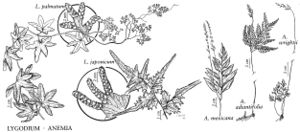Anemia
Syn. Fil. 6, 155. 1806.
| Taxon | Illustrator ⠉ | |
|---|---|---|
 | Anemia mexicana Lygodium japonicum Lygodium palmatum Anemia adiantifolia Anemia wrightii | John Myers John Myers John Myers John Myers John Myers |
Stems short-creeping, horizontal, clothed with dark hairs. Leaves partially dimorphic with sporangia restricted to erect, dissected, most proximal pair of pinnae arising from petiole just below sterile part of blade or leaves fully dimorphic and blade tissue lacking on fertile leaves. Blade 1–3-pinnate, papery to leathery. Veins free [anastomosing]. x = 38.
Distribution
Tropical and subtropical regions, North America, Mexico, West Indies, Central America, South America, 1 in Asia in s India, 10 in Africa
Discussion
Anemias are most abundant in Brazil (ca. 70 spp.) and have a secondary center of diversity in Mexico (20 spp.). They are limited in the flora to peninsular Florida and the Edwards Plateau, Texas. All 3 species belong to the calciphilic subgenus Anemiorrhiza.
Species 117 (3 in the flora).
Selected References
Lower Taxa
Key
| 1 | Blades 1-pinnate; Texas. | Anemia mexicana |
| 1 | Blades 2–3-pinnate; Florida. | > 2 |
| 2 | Leaves 2-pinnate, pinnae of leaf all fertile or all sterile; sporangia on all pinnae of fertile leaves, blade tissue lacking; sterile leaves 4–10 cm. | Anemia wrightii |
| 2 | Leaves 3-pinnate, often with dimorphic pinnae; sporangia limited to proximal pair of pinnae; sterile leaves (excluding erect fertile pinnae) 17–60 cm. | Anemia adiantifolia |